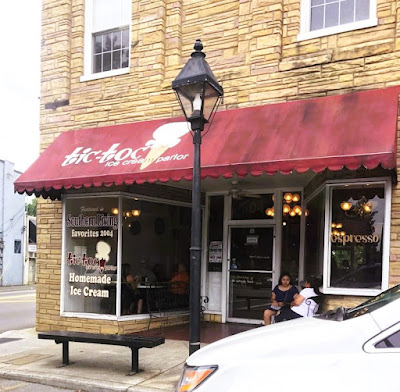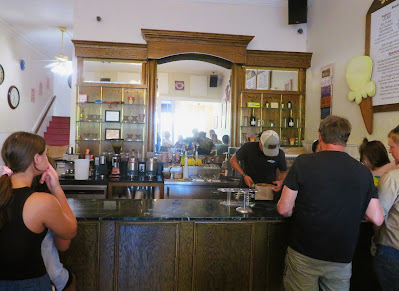I realized that my blog posts have been a bit "the same old thing" in recent weeks. Shopping and food...shopping and food. Sorry if those are the center of focus for you because I decided to go back and repost and recap those Railway Depots that really caught my eye. The depots shown below are in reverse order...the most recent favorites and then moving back until June of 2021. Since I've posted photos of 258 passenger and freight depots over the 15 years I've had a blog site, I do have a lot of material to revisit off and on over the next several months...
The plan is to mix in a bit of variety over the next couple of weeks... Railway fans enjoy!
I'll start with this handsome little depot in Federalsburg Maryland. Because I was able to find an old postcard dated in 1915 on-line, I was able to determine that this depot was over 100 years old. This is the old Maryland and Delaware depot. Nicely preserved it now functions as the offices for an operating short-line railroad, the Maryland and Delaware Railroad Company. The railroad supports a number of local industries via its 92 miles of trackage.
The next stop as I move backwards through time was this handsome and well-maintained old Depot in Princeton Indiana. Sorry about the foreground but the rail line through town is still active...so a railbed is appropriate if not beautiful. This truly old depot was built in 1875...almost 150 years ago...for the Evansville, Terre Haute and Chicago Railway. Passenger service to Princeton ended in the late 1960. It now serves as the Gibson County Visitors Center and it features a small railway museum.

Continuing with our trip via the 'way back machine', (Remember that TV cartoon show?), my next stop is at the impressive solid brick Santa Fe Passenger Depot in Marceline Missouri. It was completed in the spring of 1913 and with its size and amenities...including 107 windows and 200 - 100 watt lights, it was first class all the way. This depot closed in the 1980s, with the last Amtrak passenger train stopping here at the then unmanned depot, in 1997. It now serves as the Walt Disney Hometown Museum...
Our next stop is in Nashville Illinois. The old Louisville and Nashville Railway Depot was built in 1885 as the railroad expanded throughout southern Illinois. The design is functional and clean and the depot has been well cared for. At its peak, 7 passenger trains stopped at this little depot every day. The depot was still in service into the 1950s. All passenger service on the Louisville and Nashville Railway itself was discontinued in 1971.
This depot is a real architectural beauty... Built in the early 1890s, this depot served Charlevoix Michigan and the surrounding area. It had become a popular summer resort and in the early 1890s the Chicago and West Michigan Railroad expanded from this point north to Petoskey Michigan. After a merger, the Pere Marquette Railroad took over and they heavily promoted the eastern shore of Lake Michigan as key summer destinations. At one time, Charlevoix was served by 2 depots as well as a two-car interurban train that ran back and forth to Petosky.

Moving just a bit north, this is the former Chesapeake and Ohio Railway Station in Petosky Michigan. Built in 1892, this Victorian Shingle-style depot is now home to the Little Traverse Historical Museum. The Grand Rapids and Indiana Railroad started service to Petosky in 1874. The depot was actually built by the Chicago and West Michigan Railway. Back in the day, the Chesapeake and Ohio, (having absorbed the other railroads), operated "Resort Special" night trains from Chicago to Petosky. The depot closed during the 1950s but rail passenger service continued until about 1963.

Crossing over to the other side of Michigan's Lower Peninsula, I just had to stop and take photos of this handsome old stone depot in Standish. The town had passenger rail service from the early 1970s and by 1885, there were 8 passenger trains serving the town on a daily basis. In 1887, the Michigan Central Railroad told the town's citizens that the railroad would provide stone masons to build a depot if local farmers would haul their large field stones to the site for the new depot. This depot was completed in 1888. The last steam locomotive to bring passengers to Standish stopped here in the fall of 1955.

We stopped by this architectural gem in Durand Michigan while touring the countryside with my cousin Nathan and his better half, Janice. Built in 1903, this was a busy depot and a local office for the Grand Trunk Western and Ann Arbor Railroad. Note that there are tracks on either side of the depot. It is situated at the junction of the Canadian National Railway's mainline interchange of both the Flint and Holly divisions. In the early days, trains were sometimes boarding and discharging passengers on both side of the depot. Today this depot is owned by the City of Durand and it's leased by a non-profit that is dedicated to it's preservation.

I might be a little biased, but this depot in Jackson Michigan is one of the most striking and well preserved in the USA. Jackson also happens to be the town where I was raised, had my first job, etc. The depot has been in operation since September 1, 1873, making it the oldest continuously operating depot in the USA. The station currently serves the Amtrak "Wolverine" line which runs from Detroit to Chicago. The interior of the station is remarkable preserved and the look and woodwork harkens back to the early 1900s.
This classic small town depot is located in the town of Tecumseh Michigan. It has been relocated, having originally been located at "Tecumseh Junction" just south of downtown Tecumseh. The depot was built in 1895. The previous location was at the crossing of the north-south Lake Shore and Michigan Railway and the east-west Detroit, Toledo and Milwaukee Railroad. By 1930 the depot was closed to both passenger and freight traffic. We're lucky it hadn't been razed in the years since.
This attractive all-brick depot is located in Berea Kentucky. This depot was built in 1917 for the Louisville and Nashville Railway. The initial construction cost was $30,000. The depot featured separate waiting and restrooms for women, for men and for "people of color". Rail passenger service at Berea ceased in late 1959. The building now serves as the Berea Visitor's Center and it houses a number of museum exhibits.
This large building complex with the adjoining caboose is now home to Pierce Nebraska's Historical Museum Complex. The depot was built in 1880 for the Fremont, Elkhorn and Missouri Valley Railroad. That railroad was later incorporated into the Chicago and North Western Railroad. In the early 1900s, this depot services at least one freight and two passenger trains daily but by 1951 passenger service was discontinued. The freight depot facilities and the railway agent were both gone by 1969. The last train rolled through Pierce in June of 1978.

Here is yet another railway depot architectural masterpiece... This is the smaller of the two former depots that still exist in Lincoln Nebraska. This Renaissance style Rock Island Railroad depot was built in 1893. It served passenger needs for the Chicago, Rock Island and Pacific Railroad until 1968. Most of the railroad's trackage has been converted to 'rail trails' and this old depot now serves as a branch bank. Note the drive-through at the left of the photo.

Moving south, this is Hattiesburg Mississippi's old New Orleans and Northwestern Railroad Depot. This Italian Renaissance style depot with its clay-tile roof was built in 1910. This large depot included a 4,000 sq. ft. waiting room and its passenger platform was covered by at 924 foot long canopy...longer than 3 back-to-back football fields. The depot has been in continuous use since it opened and it currently serves Amtrak's "City of New Orleans" between New Orleans and Chicago. In addition, the depot also serves as an intermodal transportation hub and as an event center.

Just one more old depot in this first recap of these historic structures. This is the attractive and well preserved railroad station in Collins Mississippi was built by the Gulf and Ship Island Railroad and, based on a postcard photo I found on-line, I know that the depot is at least 115 years old. Originally the town was named "Williamsburg Depot", after the railroad bypassed a nearby town named Williamsburg. Most of the town relocated to "Williamsburg Depot" to be near the rail line. The town then changed its name to Collins to avoid confusion with 'the other' Williamsburg.
Just click on any of the photos to enlarge them...
Thanks for stopping by for an historic and architectural recap!
Take Care, Big Daddy Dave



















































